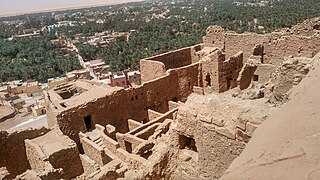Useful Info
Recent Reviews
El Menia or El Ménéa (formerly El-Goléa) (in Arabic: المنيعة, in Tamazight: Tewrirt) is a commune in the Wilaya of El Meniaa in Algeria, located 267 km southwest of Ghardaïa.
Toponymy

The name of the village منيعة (manīʿa) means impregnable, unassailable, inviolable.
El Goléa was the name given to the town before Algeria’s independence. It retained this name in the first decades after independence. El Goléa is a deformation of the name El-Kalaa, an Arabic word meaning “fortress”.
In Tamazight, it was called Taourirt, which means hill, referring to the site of the ksar.
History

The old ksar of El Menia was built in the X century by the Berber Zenetes from the Gourara region. Ibadite merchants also inhabited the ksar, and finally, the Châamba Lemmadhi occupied it from the XVI century until the French conquest.
According to legend, a Berber woman, Mebarka Bent El Khas, was appointed queen of the ksar. In the past, this ksar was a trading post for tribes in the Sahara. The ksar was abandoned before the Algerian War of Independence.
Heritage
The ksar of El Menia has been classified as a national heritage site since 1995. It is built on a pyramid-shaped hill that dominates the entire palm grove. It consists of three parts: the first part is at the foot of the hill, intended for passing caravans and visitors. The second part, also called Casbah, is the most important and was occupied by a large majority of the population. The watchtowers stand on heights overlooking the valleys.
El Menia is home to the Saint Joseph Church and the tomb of Charles de Foucauld, as well as numerous koubbas and sand roses.
The commune also has a prehistoric site.
 The old ksar. |  A koubba in the commune. |
 Saint Joseph Church |  Ruins of the old ksar. |
Personalities Linked to El Menia
- Zergat Hadda, an Algerian businesswoman, owner of the mineral water brand (El-Goléa), was born here in 1951.
- Charles de Foucauld, missionary father, died in 1916 and was first buried in Tamanrasset. His remains were moved to El Goléa in 1948. He rests in the small Christian cemetery of Saint Joseph, next to a large church nicknamed the ‘Desert Cathedral’. He also drew this oasis, as seen in his View of El-Goléa (10 November 1885), preserved in the National Library of France.
- Jean Dubuffet, painter of outsider art, stayed there three times between 1947 and 1949 because he was interested in Berber art.
- François Augiéras, writer, stayed there in 1948 with his uncle Marcel Augiéras, a retired colonial soldier. He drew inspiration from this stay to write The Old Man and the Child, which was published by Éditions de Minuit in 1954 under the pseudonym Abdallah Chaamba. El Goléa forms the backdrop of this initiation-themed novel.
- Nasreddine Degga, artist, comedian, and impersonator, was born here in 1961.
- The father of Yacine Brahimi is from this locality.
El Menia or El Ménéa (formerly El-Goléa) (in Arabic: المنيعة, in Tamazight: Tewrirt) is a commune in the Wilaya of El Meniaa in Algeria, located 267 km southwest of Ghardaïa.
Toponymy

The name of the village منيعة (manīʿa) means impregnable, unassailable, inviolable.
El Goléa was the name given to the town before Algeria’s independence. It retained this name in the first decades after independence. El Goléa is a deformation of the name El-Kalaa, an Arabic word meaning “fortress”.
In Tamazight, it was called Taourirt, which means hill, referring to the site of the ksar.
History

The old ksar of El Menia was built in the X century by the Berber Zenetes from the Gourara region. Ibadite merchants also inhabited the ksar, and finally, the Châamba Lemmadhi occupied it from the XVI century until the French conquest.
According to legend, a Berber woman, Mebarka Bent El Khas, was appointed queen of the ksar. In the past, this ksar was a trading post for tribes in the Sahara. The ksar was abandoned before the Algerian War of Independence.
Heritage
The ksar of El Menia has been classified as a national heritage site since 1995. It is built on a pyramid-shaped hill that dominates the entire palm grove. It consists of three parts: the first part is at the foot of the hill, intended for passing caravans and visitors. The second part, also called Casbah, is the most important and was occupied by a large majority of the population. The watchtowers stand on heights overlooking the valleys.
El Menia is home to the Saint Joseph Church and the tomb of Charles de Foucauld, as well as numerous koubbas and sand roses.
The commune also has a prehistoric site.
 The old ksar. |  A koubba in the commune. |
 Saint Joseph Church |  Ruins of the old ksar. |
Personalities Linked to El Menia
- Zergat Hadda, an Algerian businesswoman, owner of the mineral water brand (El-Goléa), was born here in 1951.
- Charles de Foucauld, missionary father, died in 1916 and was first buried in Tamanrasset. His remains were moved to El Goléa in 1948. He rests in the small Christian cemetery of Saint Joseph, next to a large church nicknamed the ‘Desert Cathedral’. He also drew this oasis, as seen in his View of El-Goléa (10 November 1885), preserved in the National Library of France.
- Jean Dubuffet, painter of outsider art, stayed there three times between 1947 and 1949 because he was interested in Berber art.
- François Augiéras, writer, stayed there in 1948 with his uncle Marcel Augiéras, a retired colonial soldier. He drew inspiration from this stay to write The Old Man and the Child, which was published by Éditions de Minuit in 1954 under the pseudonym Abdallah Chaamba. El Goléa forms the backdrop of this initiation-themed novel.
- Nasreddine Degga, artist, comedian, and impersonator, was born here in 1961.
- The father of Yacine Brahimi is from this locality.






